Boosting your vehicle’s speed is a delicate task. It requires a careful balance to avoid harming the engine. This article will show you how to safely up your vehicle’s speed. We’ll cover everything from basic maintenance to advanced modifications.
These methods are designed to increase power and speed. Yet, they also aim to protect your engine’s health and longevity.
Key Takeaways
- Understand the fundamentals of engine performance to identify safe tuning opportunities
- Maintain proper engine care through regular servicing and upgrades
- Explore advanced intake, fuel, and exhaust modifications to unleash more power
- Optimize weight distribution and aerodynamics for enhanced speed without strain
- Regularly monitor engine performance to ensure optimal health and efficiency
Understanding Engine Performance Fundamentals
To unlock your vehicle’s full speed, grasping the core components and principles of engine performance is vital. This section explores the essential aspects that define a power plant’s capabilities and limitations.
Basic Engine Components and Their Functions
The heart of any engine lies in its internal parts, each critical for power generation. Key components include pistons, crankshaft, camshafts, valves, and fuel delivery systems. Knowing how these components interact is the initial step towards optimizing performance.
Power-to-Weight Ratio Explained
The power-to-weight ratio is a key factor in a vehicle’s acceleration and top speed. It compares an engine’s output to the vehicle’s total weight. Vehicles with a higher power-to-weight ratio generally have better acceleration and speed.
Performance Limitations of Stock Engines
Factory-installed engines are designed for reliable, efficient operation but often have performance limits. Factors like stock engine components, tuning, and airflow restrictions can limit an engine’s power output. Recognizing these limitations is the first step towards safely boosting an engine’s speed.
| Engine Component | Function |
|---|---|
| Pistons | Convert the energy from combustion into rotational motion, driving the crankshaft. |
| Crankshaft | Converts the linear motion of the pistons into rotational motion, transmitting power to the drivetrain. |
| Camshafts | Open and close the engine’s intake and exhaust valves, controlling air and fuel flow. |
| Valves | Allow the intake of fresh air and the expulsion of exhaust gases, enabling the combustion cycle. |
| Fuel Delivery System | Supplies the appropriate air-fuel mixture to the cylinders for efficient combustion. |
“Understanding the fundamentals of engine performance is the key to unlocking your vehicle’s true speed.”
Safe Ways to Increase Speed Through Proper Maintenance
Boosting your vehicle’s performance starts with proper vehicle maintenance. Regular upkeep not only extends your engine’s life but also boosts its engine tuning and performance optimization. By taking a few simple steps, you can safely up your vehicle’s speed without harming the engine.
- Change the Oil Regularly: Regular oil changes and the right oil grade improve oil flow and reduce friction. This leads to better power delivery and responsiveness.
- Replace Air Filters: Clogged air filters limit airflow, hindering the engine’s efficiency. High-quality replacements enhance air intake and boost performance.
- Inspect and Replace Spark Plugs: Worn spark plugs cause misfires, reducing power. New, correctly gapped spark plugs improve ignition and combustion, increasing speed.
- Maintain Optimal Tire Pressure: Properly inflated tires enhance traction and reduce rolling resistance. This allows for better acceleration and higher speeds.
Adopting these straightforward vehicle maintenance practices unlocks your engine’s full capability. Remember, a well-maintained engine is essential for safe and sustainable engine tuning and performance optimization.

“Regular maintenance is the foundation for unlocking your vehicle’s true performance.
Advanced Air Intake Modifications
Enhancing your vehicle’s air intake system can unlock significant performance gains. This section explores the benefits and installation considerations of various air intake upgrades. We’ll look at cold air intakes, high-flow filters, and intake manifold enhancements.
Cold Air Intake Systems
A cold air intake system replaces the factory air box with a larger, less restrictive design. It pulls in cooler air from outside the engine bay. This setup allows more air to flow into the engine, resulting in increased horsepower and improved throttle response.
The installation process typically involves replacing the factory air filter housing with a specialized cold air intake kit. This kit includes a high-flow filter and seamless ducting to the throttle body.
High-Flow Air Filters
Upgrading to a high-flow air filter can also provide a noticeable performance boost. These filters are designed to allow more air to pass through while capturing harmful contaminants. They are often made of materials like cotton or pleated paper that offer lower restriction compared to the stock paper filters.
High-flow filters can be used in conjunction with a cold air intake for maximum airflow improvement.
Intake Manifold Upgrades
The intake manifold is responsible for distributing the air-fuel mixture to the engine’s cylinders. Upgrading to a performance-oriented intake manifold can optimize this process, resulting in increased power output. These manifolds feature larger, smoother passages that reduce airflow resistance and improve volumetric efficiency.
Installation typically requires replacing the factory manifold with a high-flow aftermarket unit.
| Modification | Potential Benefits | Considerations |
|---|---|---|
| Cold Air Intake | – Increased horsepower – Improved throttle response | – Installation complexity – Potencial engine bay clearance issues |
| High-Flow Air Filter | – Enhanced airflow – Increased power output | – Filter maintenance – Compatibility with factory air box |
| Intake Manifold Upgrade | – Improved volumetric efficiency – Higher power potencial | – Increased installation complexity – Potencial tuning requirements |
Carefully evaluating your vehicle’s specific needs and consulting with a reputable performance specialist can help you select the most suitable air intake modifications. This will unlock the full potencial of your engine.
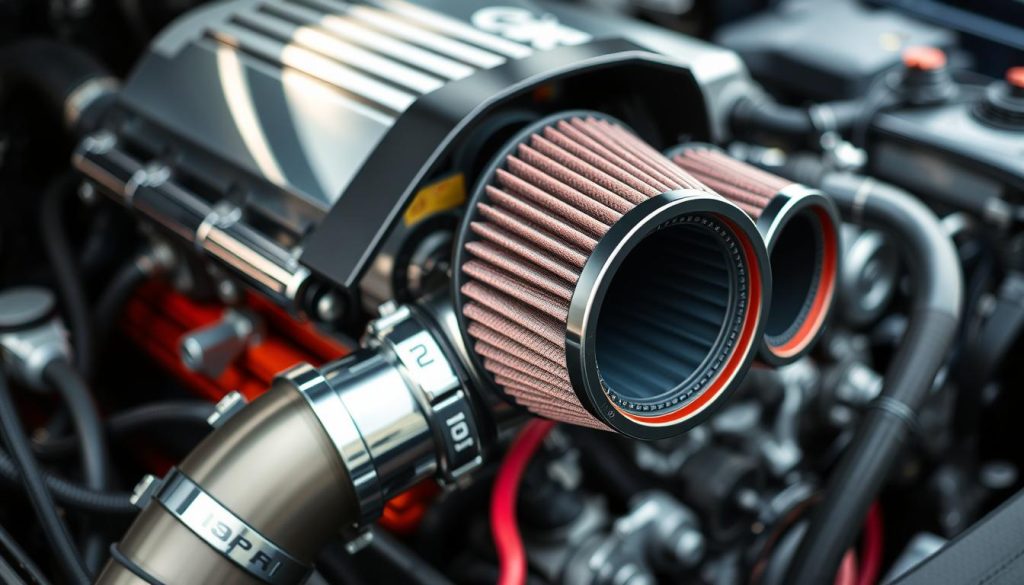
Optimizing Fuel Delivery Systems
Ensuring your vehicle’s fuel delivery system is operating at its best is key for boosting speed and performance. Upgrading fuel pumps and fine-tuning fuel pressure regulators are just a few ways to optimize your fuel delivery system. This will help maximize your power output.
Upgrading Fuel Pumps
The fuel pump is responsible for delivering the necessary amount of fuel injection to the engine. Upgrading to a higher-flow fuel pump can provide your engine with the increased fuel supply it needs. This is for improved acceleration and top-end power. Look for aftermarket fuel pump upgrades designed to handle the demands of a modified engine.
Improving Fuel Pressure
The fuel pressure regulators play a vital role in maintaining the appropriate fuel pressure for optimal engine performance. Upgrading to a high-performance regulator can ensure your engine receives the correct amount of fuel. This leads to better throttle response and power delivery.
| Fuel System Component | Function | Upgrade Benefit |
|---|---|---|
| Fuel Pump | Delivers fuel from the tank to the engine | Increased fuel flow for more power |
| Fuel Pressure Regulator | Maintains optimal fuel pressure for the engine | Precise fuel delivery for improved performance |
| Fuel Injectors | Atomizes and injects fuel into the cylinders | Increased fuel flow for enhanced power output |
By optimizing the various components of your vehicle’s fuel delivery system, you can unlock the true engine power. This will result in a significant boost in speed and responsiveness.
Performance Exhaust System Upgrades
A well-designed exhaust system can significantly boost engine performance. Optimizing exhaust gas flow and efficiency unlocks power gains and improves vehicle responsiveness. We’ll explore the benefits of exhaust system upgrades, including cat-back systems, headers, and downpipes.
Cat-Back Exhaust Benefits
The cat-back system is a popular exhaust upgrade. It replaces the exhaust from the catalytic converter to the rear. A high-quality cat-back cat-back exhaust offers several advantages:
- Increased exhaust flow for better engine breathing and power output
- Reduced backpressure for improved engine efficiency
- Enhanced sound quality with a deeper, more aggressive exhaust note
- Improved vehicle aesthetic appeal
Headers and Downpipes
Headers and downpipes are critical for efficient exhaust gas routing. Upgrading to high-quality headers and downpipes provides several benefits:
- Reduced flow restrictions for better exhaust gas evacuation
- Increased exhaust velocity for improved power and torque delivery
- Enhanced thermal efficiency for more effective heat dissipation
Exhaust Flow Optimization
The key to maximum performance is exhaust flow optimization. Analyzing and modifying exhaust components ensures smooth gas flow. Optimizing flow unlocks significant power, torque, and engine responsiveness gains.
| Exhaust Upgrade | Key Benefits |
|---|---|
| Cat-Back Exhaust | Increased flow, reduced backpressure, enhanced sound, improved aesthetics |
| Headers and Downpipes | Reduced flow restrictions, increased exhaust velocity, enhanced thermal efficiency |
Choosing and installing the right exhaust upgrades can significantly improve performance. Always consult a qualified professional to ensure modifications are safe and legal for your vehicle.
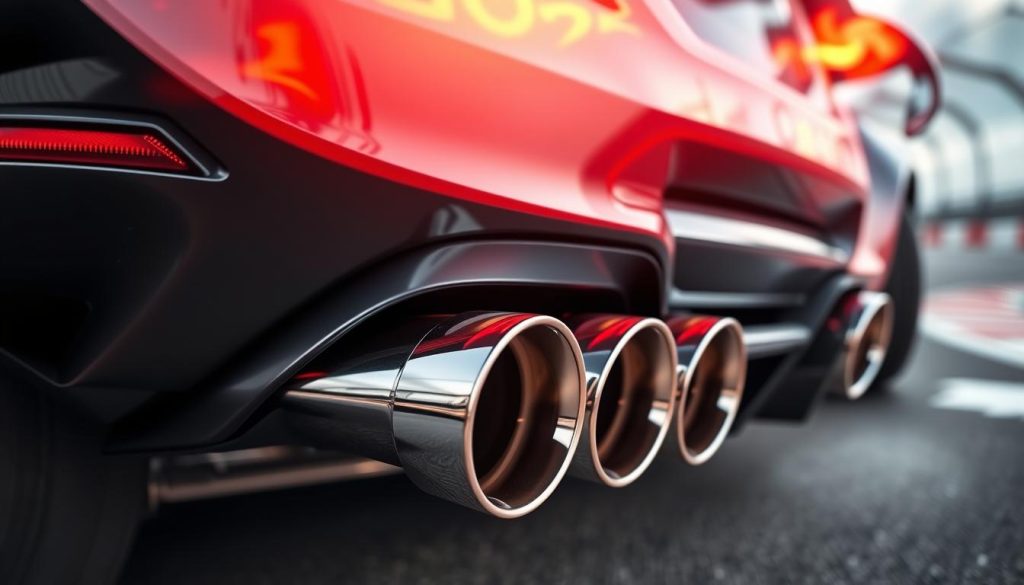
Engine Management System Tuning
Unlocking your vehicle’s hidden performance is a key goal for many. Engine management system tuning is essential for achieving this. ECU tuning, engine mapping, and performance chips can safely increase your car’s speed and power. This is done without harming its overall health.
The engine control unit (ECU) is your vehicle’s central control system. It manages fuel delivery and ignition timing, among other things. By adjusting the ECU’s settings through ECU tuning, you can enhance power and efficiency. Professional tuners can create customized maps based on your engine’s unique characteristics.
Engine mapping lets you fine-tune fuel and air ratios, ignition timing, and more. This ensures the perfect balance for your driving style. Whether you want better acceleration, improved fuel economy, or both, engine mapping offers a personalized solution.
Performance chips provide a simpler way to boost your engine’s performance. These small devices work with your ECU to deliver immediate power and torque gains. They are easy to install and offer a cost-effective way to enhance your vehicle’s performance.
| Feature | ECU Tuning | Engine Mapping | Performance Chips |
|---|---|---|---|
| Customization | High | High | Moderate |
| Installation Complexity | High | High | Low |
| Performance Gains | Significant | Significant | Moderate |
| Cost | High | High | Low |
Choosing between ECU tuning, engine mapping, or performance chips depends on your vehicle’s needs. Always work with reputable professionals to ensure safe and effective modifications. Optimizing your engine management system can unlock your vehicle’s true performance, providing a thrilling driving experience.
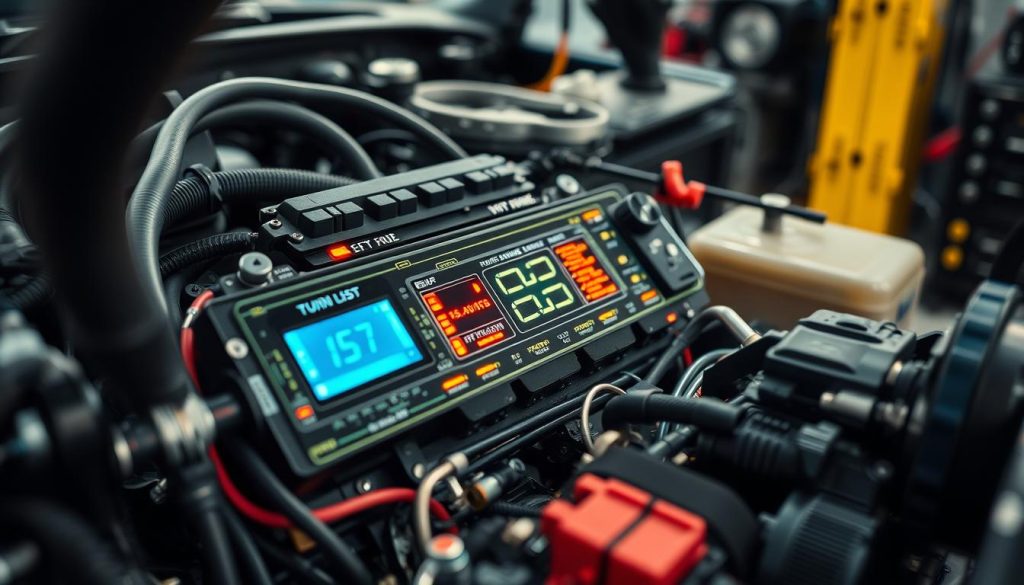
“ECU tuning is the key to unleashing your engine’s hidden power and efficiency.”
Ways to Increase Speed Through Weight Reduction
To achieve higher speeds, a balance between power and weight is essential. Reducing vehicle weight is key to boosting performance without overloading the engine. By removing unnecessary weight, you significantly enhance your power-to-weight ratio. This leads to faster acceleration and increased overall speed.
Safe Weight Reduction Methods
When reducing weight, safety must be the primary concern. Removing structural parts or vital safety features can be dangerous. Instead, consider these safe and effective methods:
- Replace heavy stock parts with lighter alternatives (e.g., aluminum or carbon fiber components)
- Remove unnecessary accessories and interior elements (such as rear seats, sound systems, and heavy trim)
- Optimize fuel tank capacity to carry only the necessary amount of fuel
Performance Impact of Weight Distribution
Proper weight distribution is vital for better handling and stability. By placing lighter components at the front and heavier ones at the rear, you achieve a balanced vehicle weight reduction. This improves your power-to-weight ratio and overall driving experience.
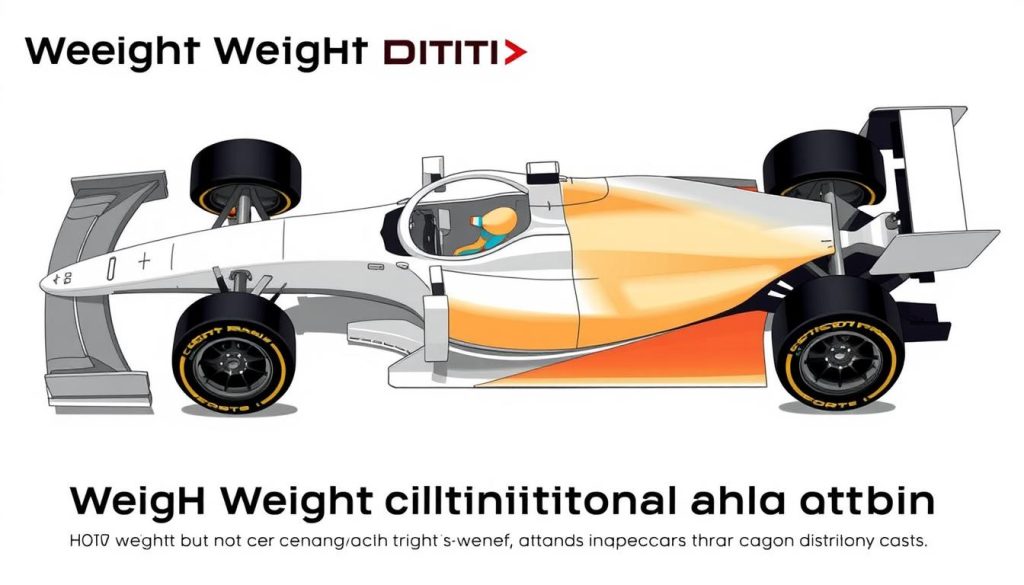
The aim is to reduce weight without harming the vehicle’s structure or safety. By carefully choosing and applying these strategies, you can achieve significant speed gains. This is done while ensuring a safe and reliable driving experience.
Transmission and Gearing Optimization
Optimizing your vehicle’s transmission and gear ratios can unlock impressive performance gains. This allows for quicker acceleration and higher top speeds. By selecting the right transmission upgrades and fine-tuning gear ratios, you can match your driving style and performance goals.
Transmission Upgrades for Better Performance
Upgrading to a more robust transmission is a key way to boost acceleration and top-end speed. You might replace the factory transmission with a heavy-duty unit or install stronger internal components. These upgrades ensure smooth power delivery, even with increased power and torque from a modified engine.
Adjusting Gear Ratios for Optimal Acceleration
Optimizing gear ratios also significantly impacts acceleration and performance. Selecting the right final drive and gear ratios tailors power delivery to your needs. Lower gear ratios enhance low-end torque and quick launches, while higher ratios maximize top speed. Finding the optimal balance is essential for unlocking your vehicle’s full performance.
Shift Point Optimization for Maximum Efficiency
Shift point optimization complements transmission and gear ratio upgrades. Adjusting the engine’s ECU or installing a standalone engine management system fine-tunes shift points. This ensures power delivery at the most efficient rpm range, improving acceleration, fuel economy, and reducing engine wear.
| Modification | Performance Benefit | Considerations |
|---|---|---|
| Transmission Upgrades | Improved power handling, smoother power delivery | Compatibility with existing engine and drivetrain components |
| Gear Ratio Adjustments | Enhanced acceleration and top speed | Balancing low-end torque and high-end speed |
| Shift Point Optimization | Improved efficiency, reduced engine wear | Compatibility with engine management system |
By choosing the right transmission upgrades, adjusting gear ratios, and optimizing shift points, you can transform your vehicle’s performance. These modifications enhance reliability and drivability, unleashing your ride’s full power and delivering a thrilling driving experience.
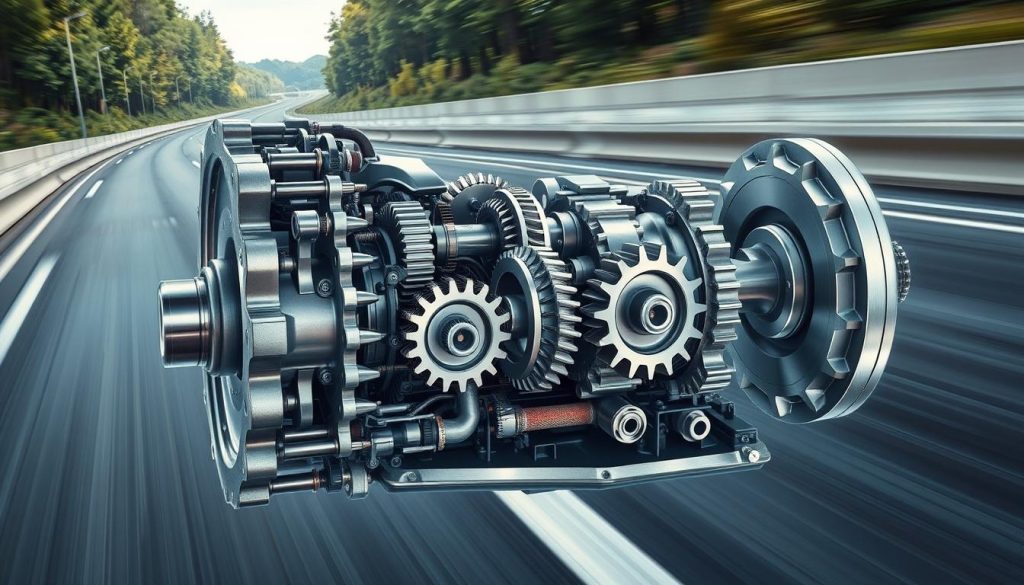
Performance Tire Selection and Maintenance
Choosing the right performance tires and maintaining them properly is key to unlocking your vehicle’s full speed. The type of tire compound and optimal tire pressure greatly affect your car’s acceleration, handling, and performance.
Tire Compound Types
Performance tires vary in compound types, each excelling in different driving conditions:
- Summer tires: Exceptional grip and responsiveness for dry, warm weather.
- All-season tires: Balanced performance and all-weather capability.
- Winter tires: Focus on traction and control in cold, snowy, or icy conditions.
When picking performance tires, think about the climate, your driving style, and the roads you’ll be on. This ensures the best fit for your needs.
Optimal Tire Pressure for Speed
Keeping the correct tire pressure is vital for maximizing speed and handling. Underinflated tires increase rolling resistance, reduce fuel efficiency, and harm cornering. Overinflated tires can make the ride harsh and lower traction.
Check your vehicle’s owner’s manual or the information placard on the driver’s side door jamb for the recommended tire pressure. Regularly checking and adjusting tire pressure can significantly improve your car’s acceleration, braking, and responsiveness.
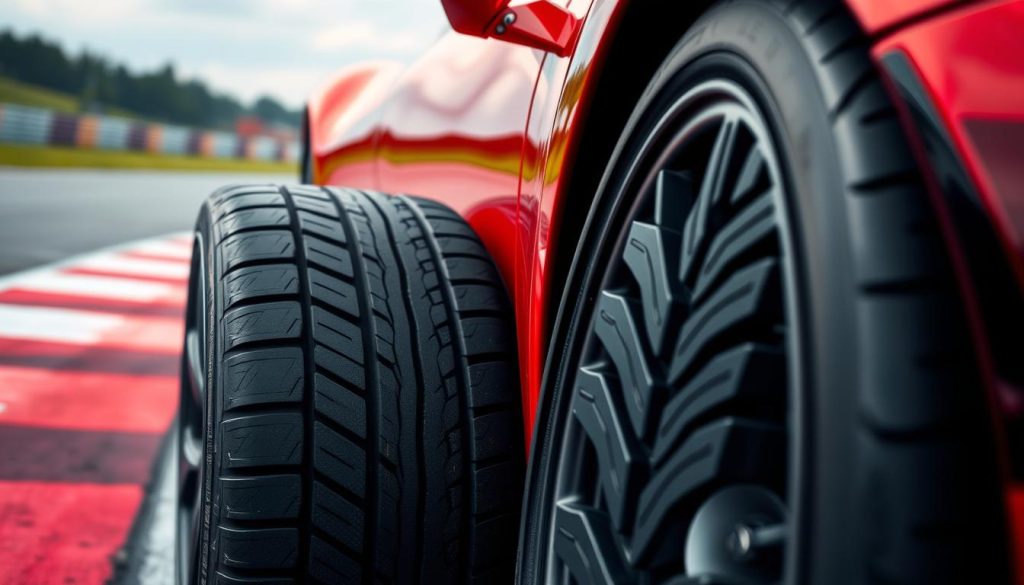
“The right tires can transform a vehicle’s performance, unlocking its true speed and handling.”
Understanding the importance of performance tire selection and maintenance can elevate your driving experience. It allows you to safely reach the speeds you desire.
Aerodynamic Modifications for Better Performance
Enhancing your vehicle’s vehicle aerodynamics significantly boosts its speed and performance. By making targeted body modifications, you can cut down on drag reduction and increase downforce. These changes are key to a car’s speed and handling.
Installing a body kit is a top aerodynamic upgrade. These kits include a front spoiler, side skirts, and a rear diffuser. Together, they streamline airflow, reducing drag and boosting downforce. This enhances traction and cornering.
- Front spoilers guide air over and under the car, reducing lift and improving stability at high speeds.
- Side skirts close the gap between the body and the road, cutting drag and increasing downforce.
- Rear diffusers speed up airflow under the vehicle, creating more downforce on the rear axle for better grip and cornering.
Adding a rear spoiler or wing is another popular upgrade. These elements produce downforce on the rear axle, countering the tendency to become unstable at high speeds. This leads to faster lap times and more confident high-speed driving.
By focusing on vehicle aerodynamics, drag reduction, and downforce, you can maximize your vehicle’s performance. These upgrades not only increase speed but also enhance handling and safety. They make your driving experience more thrilling than ever.
Engine Cooling System Enhancements
Keeping the engine at the right temperature is key for performance and longevity. Powerful engines produce a lot of heat, but a good cooling system prevents overheating and damage. We’ll look at the importance of radiator upgrades and high-performance coolants for better speed and reliability.
Radiator Upgrades
The radiator is the core of the cooling system, responsible for removing engine heat. Stock radiators often can’t handle the heat of high-performance driving. A bigger, more efficient radiator can greatly improve cooling, letting your engine run at its best without overheating.
- Increased cooling capacity: Larger radiators with more surface area can dissipate heat more effectively, keeping engine temperatures within the optimal range.
- Improved airflow: Optimized radiator design and fan configurations can enhance airflow, further improving cooling system efficiency.
- Durability: High-quality radiator materials and construction can withstand the rigors of high-performance driving, ensuring reliable cooling over time.
Coolant Selection and Maintenance
The coolant type significantly affects engine temperature management. Performance coolants are made for better heat transfer and corrosion protection, ensuring optimal cooling under demanding conditions.
| Coolant Type | Key Benefits | Recommended Use |
|---|---|---|
| Ethylene Glycol-based | Affordable, widely available, good heat transfer | Standard road use |
| Propylene Glycol-based | Less toxic, excellent corrosion protection | High-performance applications |
| Nitrite-free Organic Acid Technology (OAT) | Exceptional heat transfer, long-lasting corrosion protection | High-performance, race-inspired use |
Regular coolant maintenance, including flushing and replacement, is vital for system efficiency and preventing overheating or engine damage.
Upgrading your radiator and choosing the right coolant ensures your engine stays at the optimal temperature. This lets you push performance limits without risking reliability.
Regular Performance Testing and Monitoring
Consistent performance testing and monitoring are key to safely boosting your vehicle’s speed. This section delves into various testing methods. These include dynamometer (dyno) runs and data logging. They help track performance gains and spot issues early on.
Dyno testing measures your engine’s power and torque under controlled conditions. It offers valuable insights into the effectiveness of your modifications. By analyzing the data, you can refine your setup. This ensures your upgrades meet your expectations.
Data logging, in contrast, monitors your vehicle’s performance in real-world driving. It records engine speed, throttle position, and coolant temperature. This helps identify emerging issues and maintain optimal performance. Regular data logging keeps you ahead of problems and maximizes upgrade benefits.
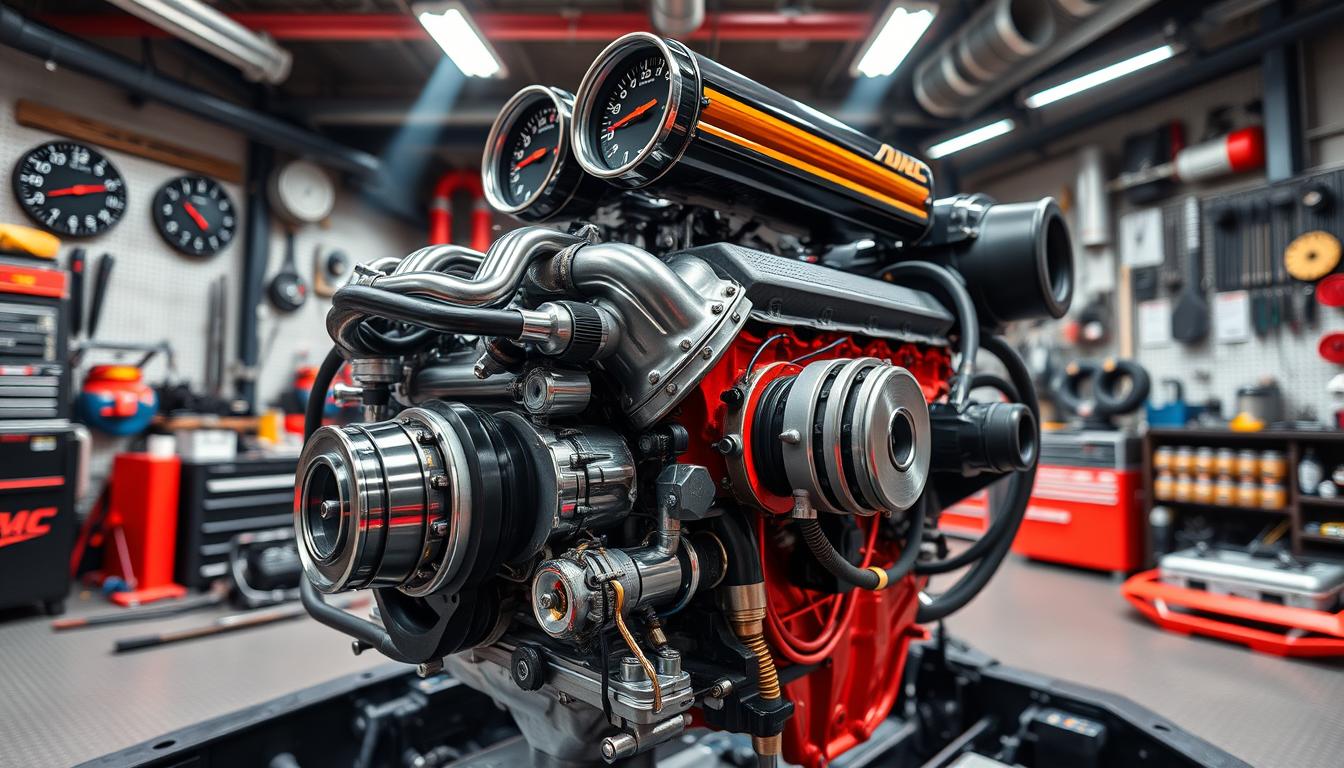
Leave a Reply